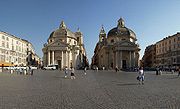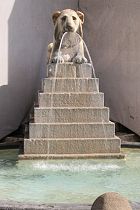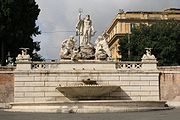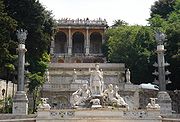
Piazza del Popolo
Encyclopedia

Rome
Rome is the capital of Italy and the country's largest and most populated city and comune, with over 2.7 million residents in . The city is located in the central-western portion of the Italian Peninsula, on the Tiber River within the Lazio region of Italy.Rome's history spans two and a half...
. The name in modern Italian
Italian language
Italian is a Romance language spoken mainly in Europe: Italy, Switzerland, San Marino, Vatican City, by minorities in Malta, Monaco, Croatia, Slovenia, France, Libya, Eritrea, and Somalia, and by immigrant communities in the Americas and Australia...
literally means "People's Square", but historically it derives from the poplar
Poplar
Populus is a genus of 25–35 species of deciduous flowering plants in the family Salicaceae, native to most of the Northern Hemisphere. English names variously applied to different species include poplar , aspen, and cottonwood....
s (populus in Latin, pioppo in Italian) after which the church of Santa Maria del Popolo
Santa Maria del Popolo
Santa Maria del Popolo is an Augustinian church located in Rome, Italy.It stands to the north side of the Piazza del Popolo, one of the most famous squares in the city. The Piazza is situated between the ancient Porta Flaminia and the park of the Pincio...
, in the northeast corner of the piazza, takes its name.
The piazza lies inside the northern gate in the Aurelian Walls
Aurelian Walls
The Aurelian Walls is a line of city walls built between 271 and 275 in Rome, Italy, during the reign of the Roman Emperors Aurelian and Probus....
, once the Porta Flaminia of ancient Rome
Ancient Rome
Ancient Rome was a thriving civilization that grew on the Italian Peninsula as early as the 8th century BC. Located along the Mediterranean Sea and centered on the city of Rome, it expanded to one of the largest empires in the ancient world....
, and now called the Porta del Popolo. This was the starting point of the Via Flaminia
Via Flaminia
The Via Flaminia was an ancient Roman road leading from Rome over the Apennine Mountains to Ariminum on the coast of the Adriatic Sea, and due to the ruggedness of the mountains was the major option the Romans had for travel between Etruria, Latium and Campania and the Po Valley...
, the road to Ariminum (modern day Rimini
Rimini
Rimini is a medium-sized city of 142,579 inhabitants in the Emilia-Romagna region of Italy, and capital city of the Province of Rimini. It is located on the Adriatic Sea, on the coast between the rivers Marecchia and Ausa...
) and the most important route to the north. At the same time, before the age of railroads, it was the traveller's first view of Rome upon arrival. For centuries, the Piazza del Popolo was a place for public executions, the last of which took place in 1826.
Valadier's design



Neoclassical architecture
Neoclassical architecture was an architectural style produced by the neoclassical movement that began in the mid-18th century, manifested both in its details as a reaction against the Rococo style of naturalistic ornament, and in its architectural formulas as an outgrowth of some classicizing...
style between 1811 and 1822 by the architect Giuseppe Valadier
Giuseppe Valadier
Giuseppe Valadier was an Italian architect and designer, urban planner and archeologist, a chief exponent of Neoclassicism in Italy.-Biography:...
, He removed a modest fountain by Giacomo Della Porta
Giacomo della Porta
Giacomo della Porta was an Italian architect and sculptor, who worked on many important buildings in Rome, including St. Peter's Basilica. He was born at Porlezza, Lombardy and died in Rome.-Biography:...
, erected in 1572, and demolished some insignificant buildings and haphazard high screening walls to form two semicircle
Semicircle
In mathematics , a semicircle is a two-dimensional geometric shape that forms half of a circle. Being half of a circle's 360°, the arc of a semicircle always measures 180° or a half turn...
s, reminiscent of Bernini's plan for St. Peter's Square, replacing the original cramped trapezoidal
Trapezium
The word trapezium has several meanings:* - a quadrilateral with one pair of parallel sides ....
square centred on the Via Flaminia.
Valadier's Piazza del Popolo, however, incorporated the verdure of trees as an essential element; he conceived his space in a third dimension, expressed in the building of the viale that leads up to the balustraded overlook from the Pincio (above, right).
An Egypt
Egypt
Egypt , officially the Arab Republic of Egypt, Arabic: , is a country mainly in North Africa, with the Sinai Peninsula forming a land bridge in Southwest Asia. Egypt is thus a transcontinental country, and a major power in Africa, the Mediterranean Basin, the Middle East and the Muslim world...
ian obelisk
Obelisk
An obelisk is a tall, four-sided, narrow tapering monument which ends in a pyramid-like shape at the top, and is said to resemble a petrified ray of the sun-disk. A pair of obelisks usually stood in front of a pylon...
of Sety I (later erected by Rameses II) from Heliopolis
Heliopolis (ancient)
Heliopolis was one of the oldest cities of ancient Egypt, the capital of the 13th Lower Egyptian nome that was located five miles east of the Nile to the north of the apex of the Nile Delta...
stands in the centre of the Piazza. Three sides of the obelisk were carved during the reign of Sety I and the fourth side, under Rameses II. The obelisk, known as the obelisco Flaminio or the Popolo Obelisk, is the second oldest and one of the tallest obelisks in Rome
Obelisks in Rome
The city of Rome harbours the most obelisks in the world. There are eight ancient Egyptian and five ancient Roman obelisks in Rome, together with a number of more modern obelisks; there was also formerly an ancient Ethiopian obelisk in Rome....
(some 24 m high, or 36 m including its plinth
Plinth
In architecture, a plinth is the base or platform upon which a column, pedestal, statue, monument or structure rests. Gottfried Semper's The Four Elements of Architecture posited that the plinth, the hearth, the roof, and the wall make up all of architectural theory. The plinth usually rests...
). The obelisk was brought to Rome in 10 BC
10 BC
Year 10 BC was either a common year starting on Tuesday, Wednesday or Thursday or a leap year starting on Tuesday or Wednesday of the Julian calendar and a common year starting on Sunday of the Proleptic Julian calendar...
by order of Augustus
Augustus
Augustus ;23 September 63 BC – 19 August AD 14) is considered the first emperor of the Roman Empire, which he ruled alone from 27 BC until his death in 14 AD.The dates of his rule are contemporary dates; Augustus lived under two calendars, the Roman Republican until 45 BC, and the Julian...
and originally set up in the Circus Maximus
Circus Maximus
The Circus Maximus is an ancient Roman chariot racing stadium and mass entertainment venue located in Rome, Italy. Situated in the valley between the Aventine and Palatine hills, it was the first and largest stadium in ancient Rome and its later Empire...
. It was re-erected here in the piazza by the architect-engineer Domenico Fontana
Domenico Fontana
Domenico Fontana was a Swiss-born Italian architect of the late Renaissance.-Biography:200px|thumb|Fountain of Moses in Rome....
in 1589 as part of the urban plan of Sixtus V
Pope Sixtus V
Pope Sixtus V , born Felice Peretti di Montalto, was Pope from 1585 to 1590.-Early life:The chronicler Andrija Zmajević states that Felice's family originated from modern-day Montenegro...
. The piazza also formerly contained a central fountain, which was moved to the Piazza Nicosia in 1818, when fountains, in the form of Egyptian-style lions, were added around the base of the obelisk.
Looking from the north (illustration, right), three streets branch out from the piazza into the city, forming the so-called "trident
Trident
A trident , also called a trishul or leister or gig, is a three-pronged spear. It is used for spear fishing and was also a military weapon. Tridents are featured widely in mythical, historical and modern culture. The major Hindu god, Shiva the Destroyer and the sea god Poseidon or Neptune are...
" (il Tridente): the Via del Corso
Via del Corso
The Via del Corso , commonly known as the Corso, is a main street in the historical centre of Rome. It is remarkable for being absolutely straight in an area characterized by narrow meandering alleys and small piazzas...
in the centre; the Via del Babuino to the left (opened in 1525 as the Via Paolina) and the Via di Ripetta (opened by Leo X
Pope Leo X
Pope Leo X , born Giovanni di Lorenzo de' Medici, was the Pope from 1513 to his death in 1521. He was the last non-priest to be elected Pope. He is known for granting indulgences for those who donated to reconstruct St. Peter's Basilica and his challenging of Martin Luther's 95 Theses...
in 1518 as the Via Leonina) to the right. The twin
Twin
A twin is one of two offspring produced in the same pregnancy. Twins can either be monozygotic , meaning that they develop from one zygote that splits and forms two embryos, or dizygotic because they develop from two separate eggs that are fertilized by two separate sperm.In contrast, a fetus...
churches (the chiese gemelle) of Santa Maria dei Miracoli
Santa Maria dei Miracoli
Italian churches:* Santa Maria dei Miracoli and Santa Maria in Montesanto in Rome* Santa Maria dei Miracoli, Venice* Santa Maria presso San Celso in Milan...
(1681) and Santa Maria in Montesanto (1679), begun by Carlo Rainaldi
Carlo Rainaldi
Carlo Rainaldi was an Italian architect of the Baroque period.Born in Rome, Rainaldi was one of the leading architects of 17th century Rome, known for a certain grandeur in his designs. He worked at first with his father, Girolamo Rainaldi, a late Mannerist architect in Rome. After his father's...
and completed by Bernini and Carlo Fontana
Carlo Fontana
Carlo Fontana was an Italian architect, who was in part responsible for the classicizing direction taken by Late Baroque Roman architecture.-Biography:...
, define the junctions of the roads. Close scrutiny of the twin churches reveals that they are not mere copies of one another, as they would have been in a Neoclassical
Neoclassicism
Neoclassicism is the name given to Western movements in the decorative and visual arts, literature, theatre, music, and architecture that draw inspiration from the "classical" art and culture of Ancient Greece or Ancient Rome...
project, but vary in their details, offering variety within their symmetrical balance in Baroque
Baroque
The Baroque is a period and the style that used exaggerated motion and clear, easily interpreted detail to produce drama, tension, exuberance, and grandeur in sculpture, painting, literature, dance, and music...
fashion.
The central street, now known as the Via del Corso, was the ancient Via Lata and to the north it links with the ancient Roman road, the Via Flaminia,beyond the city gate and southwards, to the Piazza Venezia (formerly the Piazza San Marco), the Capitol
Capitoline Hill
The Capitoline Hill , between the Forum and the Campus Martius, is one of the seven hills of Rome. It was the citadel of the earliest Romans. By the 16th century, Capitolinus had become Capitolino in Italian, with the alternative Campidoglio stemming from Capitolium. The English word capitol...
and the forum
Roman Forum
The Roman Forum is a rectangular forum surrounded by the ruins of several important ancient government buildings at the center of the city of Rome. Citizens of the ancient city referred to this space, originally a marketplace, as the Forum Magnum, or simply the Forum...
. The Via di Ripetta leads past the Mausoleum of Augustus
Mausoleum of Augustus
The Mausoleum of Augustus is a large tomb built by the Roman Emperor Augustus in 28 BC on the Campus Martius in Rome, Italy. The Mausoleum, now located on the Piazza Augusto Imperatore, is no longer open to tourists, and the ravages of time and carelessness have stripped the ruins bare...
to the River Tiber
Tiber
The Tiber is the third-longest river in Italy, rising in the Apennine Mountains in Emilia-Romagna and flowing through Umbria and Lazio to the Tyrrhenian Sea. It drains a basin estimated at...
, where the Baroque riverside landing called the Porto di Ripetta
Porto di Ripetta
The Porto di Ripetta was a port in the city of Rome. It was situated on the banks of the River Tiber and was designed and built in 1707 by the Italian Baroque architect Alessandro Specchi . Located in front of the church of San Girolamo degli Schiavoni, its low walls with steps descended in...
was located until it was destroyed in the late nineteenth century. The Via del Babuino ("Baboon"), linking to Piazza di Spagna, takes its name from a grotesque sculpture of Silenus
Silenus
In Greek mythology, Silenus was a companion and tutor to the wine god Dionysus.-Evolution of the character:The original Silenus resembled a folklore man of the forest with the ears of a horse and sometimes also the tail and legs of a horse...
that gained the popular name of "the Baboon".
To the north of the piazza stands the Porta del Popolo, beyond which lies the Piazzale Flaminio
Piazzale Flaminio
Piazzale Flaminio is a square in Rome just outside the Aurelian Walls, and the starting point of the Via Flaminia. The Porta del Popolo on its south side connects it to the Piazza del Popolo.The Flaminio-Piazza del Popolo metro station is located here....
and the start of the Via Flaminia. The gateway was reworked to give its current appearance by Bernini for Pope Alexander VII
Pope Alexander VII
Pope Alexander VII , born Fabio Chigi, was Pope from 7 April 1655, until his death.- Early life :Born in Siena, a member of the illustrious banking family of Chigi and a great-nephew of Pope Paul V , he was privately tutored and eventually received doctorates of philosophy, law, and theology from...
in 1655, to welcome Queen Christina of Sweden
Christina of Sweden
Christina , later adopted the name Christina Alexandra, was Queen regnant of Swedes, Goths and Vandals, Grand Princess of Finland, and Duchess of Ingria, Estonia, Livonia and Karelia, from 1633 to 1654. She was the only surviving legitimate child of King Gustav II Adolph and his wife Maria Eleonora...
to Rome following her conversion to Roman Catholicism and her abdication
Abdication
Abdication occurs when a monarch, such as a king or emperor, renounces his office.-Terminology:The word abdication comes derives from the Latin abdicatio. meaning to disown or renounce...
. Opposite Santa Maria del Popolo stands a Carabinieri
Carabinieri
The Carabinieri is the national gendarmerie of Italy, policing both military and civilian populations, and is a branch of the armed forces.-Early history:...
station, with a dome reflecting that of the church.

Urbanism
Broadly, urbanism is a focus on cities and urban areas, their geography, economies, politics, social characteristics, as well as the effects on, and caused by, the built environment.-Philosophy:...
, Valadier constructed the matching palazzi that provide a frame for the scenography of the twin churches and hold down two corners of his composition. He positioned a third palazzo to face these and matched a low structure screening the flank of Santa Maria del Popolo, with its fine Early Renaissance façade, together holding down the two northern corners. Valadier outlined this newly-defined oval forecourt to the city of Rome with identical sweeps of wall, forming curving exedra
Exedra
In architecture, an exedra is a semicircular recess or plinth, often crowned by a semi-dome, which is sometimes set into a building's facade. The original Greek sense was applied to a room that opened onto a stoa, ringed with curved high-backed stone benches, a suitable place for a philosophical...
-like spaces. Behind the western one, a screen of trees masks the unassorted fronts of buildings beyond.
Fountains
The aqueduct carrying the Acqua Vergine Nuovo was completed in the 1820s, and its water provided the opportunity for fountains and their basins that offered the usual public water supply for the rioneor urban district. Ever since the Renaissance such terminal fountains also provided an occasion for the grand terminal water show called in Rome a mostra or a show. "What makes a fountain a mostra is not essentially its size or splendor, but its specific designation as the fountain that is a public memorial to the whole achievement of the aqueduct." Valadier had planned fountains in the upper tier of the Pincio slope, but these were not carried out, in part for lack of water.Fountains by Giovanni Ceccarini (1822–23), with matching compositions of a central figure flanked by two attendant figures, stand on each side of the piazza to the east and west, flanked by neoclassical statues of The Seasons (1828). The Fontana del Nettuno
Fontana del Nettuno, Piazza del Popolo
The Fontana del Nettuno is a monumental fountain located in the Piazza del Popolo in Rome. It was constructed in the 1822-23 at the terminus of a newly-built aqueduct, the Acqua Vergine Nuovo. The fountains in the Piazza del Popolo were the work of Giovanni Ceccarini...
(Fountain of Neptune) stands on the west side, Neptune
Neptune
Neptune is the eighth and farthest planet from the Sun in the Solar System. Named for the Roman god of the sea, it is the fourth-largest planet by diameter and the third largest by mass. Neptune is 17 times the mass of Earth and is slightly more massive than its near-twin Uranus, which is 15 times...
with his trident
Trident
A trident , also called a trishul or leister or gig, is a three-pronged spear. It is used for spear fishing and was also a military weapon. Tridents are featured widely in mythical, historical and modern culture. The major Hindu god, Shiva the Destroyer and the sea god Poseidon or Neptune are...
is accompanied by two dolphins. Rome between the Tiber
Tiber
The Tiber is the third-longest river in Italy, rising in the Apennine Mountains in Emilia-Romagna and flowing through Umbria and Lazio to the Tyrrhenian Sea. It drains a basin estimated at...
and the Aniene
Aniene
-External links:* http://www.humnet.ucla.edu/humnet/horaces-villa/glossary/Anio.gloss.html*...
on the east side, against the steep slope of the Pincio, represents the terminal mostra of the aqueduct. Dea Roma
Roma (mythology)
In traditional Roman religion, Roma was a female deity who personifed the city of Rome and more broadly, the Roman state. Her image appears on the base of the column of Antoninus Pius.-Problems in earliest attestation:...
armed with lance and helmet, and in front is the she-wolf
Capitoline Wolf
The Capitoline Wolf is a bronze sculpture of a she-wolf suckling twin infants, inspired by the legend of the founding of Rome. According to the legend, when Numitor, grandfather of the twins Romulus and Remus, was overthrown by his brother Amulius, the usurper ordered the twins to be cast into...
feeding Romulus and Remus
Romulus and Remus
Romulus and Remus are Rome's twin founders in its traditional foundation myth, although the former is sometimes said to be the sole founder...
.
At the center of the piazza is the Fontana dell' Obelisco: a group of four mini fountains, each comprising a lion on a stepped plinth, surround the obelisk.
Urbanisation in three dimensions

Pincian Hill
The Pincian Hill is a hill in the northeast quadrant of the historical center of Rome. The hill lies to the north of the Quirinal, overlooking the Campus Martius...
of ancient Rome, which overlooked the space from the east. He swept away informally terraced gardens that belonged to the Augustinian monastery connected with Santa Maria del Popolo. In its place he created a carriage drive that doubled back upon itself and pedestrian steps leading up beside a waterfall
Waterfall
A waterfall is a place where flowing water rapidly drops in elevation as it flows over a steep region or a cliff.-Formation:Waterfalls are commonly formed when a river is young. At these times the channel is often narrow and deep. When the river courses over resistant bedrock, erosion happens...
to the Pincio park, where a balustraded lookout, supported by a triple-arched nymphaeum is backed by a wide gravelled opening set on axis with the piazza below; formally-planted bosquet
Bosquet
In the French formal garden, a bosquet is a formal plantation of trees, at least five of identical species planted as a quincunx, or set in strict regularity as to rank and file, so that the trunks line up as one passes along either face...
s of trees flank the open space. The planted Pinco in turn provides a link to the Villa Borghese gardens
Villa Borghese gardens
Villa Borghese is a large landscape garden in the naturalistic English manner in Rome, containing a number of buildings, museums and attractions. It is the second largest public park in Rome after that of the Villa Doria Pamphili...
.
Until quite recently, the Piazza del Popolo was choked with traffic
Traffic
Traffic on roads may consist of pedestrians, ridden or herded animals, vehicles, streetcars and other conveyances, either singly or together, while using the public way for purposes of travel...
in a sea of car parking. Today, it is a pedestrian zone.

